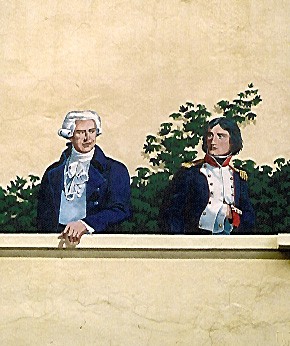In February 1979, the A Bandera association was formed, an organisation with the mission to promote interest in the military history of Corsica. And this goal was to be achieved through a periodical, through conferences and through a museum with one permanent and occasional temporary exhibitions. This museum has been in being since 1989 and as such it is a
fascinating introduction to the discovery of the soul and culture of Corsica.
The “A Bandera” Museum of the History of Mediterranean Corsica is easily recognised from the outside by the multicoloured fresco on the façade showing three of the island’s most celebrated inhabitants, Sampiero, Paoli and Bonaparte (see inset). The museum itself presents a complete retrospective of ten thousand years of struggle against, and exchange with, conquerors and traders from Europe and the whole of the Mediterranean. Beginning with detailed explanatory boards, a variety of documents, arms, uniforms, costumes, figurines and dioramas, the
museum traces the tumultuous history of the islands and its inhabitants.
The first room is dedicated to Prehistory, Antiquity and the Middle Ages. The second gives a presentation of Corsica’s relationship with the sea, saracen and barbarian piracy, as well as Genoese domination. The 18th century is the subject of the third room. Here the visitor can read long descriptions of Paoli’s republic and the French conquest, and these written pieces are backed up by exhibits of every sort, notably: Paoli’s personal stamp, the proof of a printed manifesto with manuscript corrections by Paoli himself, a letter dated 20 December 1769 from Louis XV to the island’s Conseil supérieur, a diorama of the battle of Ponte Nuovo, 8 May
1796, bullets from that battle, a bust of Paoli, a model of the port of Ajaccio in 1770, a coat of arms of the Anglo-Corsican kingdom, arms, bayonets, pistols and engravings.
The fourth room is dedicated entirely to the history of the First and Second Empires. Certain items (arms and uniforms) are boldy placed alongside models, such as of the Emperor’s barge (as used during a visit to Antwerp with Marie-Louise) and of the Belle Poule (the ship which brought Napoleon’s mortal remains back from St Helena). Of particular note is a board dedicated entirely to general Morand, the hated commander-in-chief of Corsica between 1801 and 1809. The First Empire is only superficially dealt with, perhaps because of the lack of space which would not allow the complete collection of uniforms to be put on show. There is more on the Second Empire, with many extracts from journals. Most notable is a delightful series of caricatures from the Ménagerie impériale which present the protagonists of imperial
power in animal form (Napoleon the Eagle, Morny the fox, Haussman the beaver, Persigny the monkey, etc.). The Prince Impérial receives a privileged place with an ensemble of exhibits on his tragic death in South Africa. Of particular note is his dress sword. Busts, engravings, articles from journals, zouave, gendarme and canteen uniforms complete the display. The last room follows the modern period, notably the experience of Corsica in the last two world wars.
Since its creation, the museum has organised about fifty thematic exhibitions recounting such diverse matters as the barbarian invasions, the Bloody Islands up to the First World War, Bandits, the Army in Africa, Corsican Women, and of course Pascal Paoli and the Corsican state, the general Abbatuci, Napoleon in the Mediterranean and the Second Empire.
The museum moved in 2016 to the town of Ghisonaccia


